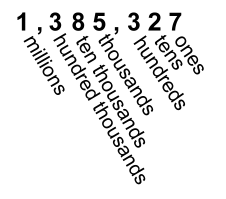 Numeric answers to problems often need to be rounded. Sometimes it's because the measurements used aren't very precise. Other times, with decimal numbers, it may be because the calculation has a fractional value which repeats forever, such as ⅔, or because there is an irrational number in the calculation, such as π, which also is infinite in length; both must be rounded. Finally, the reason may be as simple as the question asking you to. On this page we'll review how rounding works, both for whole numbers (Math 6/7) and for decimals (Math 7/8/9). Rounding Whole Numbers You will need to be familiar with place value names. Here are a few:  Example 1: Round 3,279 to the nearest ten. In the number 3,279 '7' is the tens digit. The digit after that is a 9, which is bigger than or equal to 5, so the 7 rounds up to an 8. The ones digit becomes 0. So 3,279 rounded to the nearest ten is 3,280. This is the same as saying 3,279 is closer to 3,280 than 3,270. Example 2: Round 837 to the nearest hundred. In the number 837, '8' is the hundreds digit. The digit after that is a 3, which is smaller than 5, so the 8 doesn't change. The rest of the digits become 0. So 837 rounded to the nearest hundred is 800. This is the same as saying 837 is closer to 800 than 900. Example 3: Round 12,527 to the nearest thousand. In the number 12,527, '2' is the thousands digit. The digit after that is a 5, which is bigger than or equal to 5, so the 2 rounds up to a 3. The rest of the digits become 0. So 12,527 rounded to the nearest thousand is 13,000. This is the same as saying 12,527 is closer to 13,000 than 12,000. Example 4: Round 50 to the nearest hundred. In the number 050, the unwritten '0' is the hundreds digit. The digit after that is a 5, which is bigger than or equal to 5, so the 0 rounds up to a 1. The rest of the digits become 0. So 50 rounded to the nearest hundred is 100. This is the same as saying 50 is closer to 100 than 0, because it's at least half way. Example 5: Round 7,996 to the nearest ten. In the number 7,996, the bolded '9' is the tens digit. The digit after that is a 6, which is bigger than or equal to 5, so the 9 rounds up to a 10. The '1' carries to the left to make the next '9' a '10'. That '1' carries to the left to make the '7' become an '8'. The number after the digit 9 we were rounding, the '6', becomes 0. So 7,996 rounded to the nearest ten is 8000. This is the same as saying 7,996 is closer to 8000 than 7000, 7990, or 7900. Rounding Whole Numbers: Find the digit you're rounding. The number on its right determines whether it stays the same or goes up by 1. If that number is 5 or bigger, the digit goes up 1; if it's less than 5 the digit stays the same. The digits following are changed to zeros. |